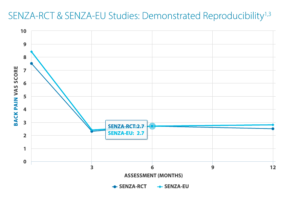A spinal cord stimulator (SCS) is an electronic device placed over the nerves in the spine. When activated, it generates small electric fields that block pain sensations from being transmitted up the spinal cord to the brain. Although the mechanisms by which it works are not fully understood, the stimulator seems to create interference so that pain signals coming from the spine are less noticeable. It can be thought of as similar to what happens why you try to hear what is said in a crowded, noisy room. It is much harder to understand and frequently words are missed or not heard at all.
The most common reason for a SCS is persistent back and leg pain that has gone on for at least six months, and where other forms of treatment, like spinal injections, physical therapy, or previous spine surgery, have been ineffective. Typical conditions addressed by SCS therapy include diagnoses like arachnoiditis, complex regional pain syndrome, failed-back syndrome, post-laminectomy syndrome (lumbar or cervical), nerve damage, neuropathy, or neuritis.
If you have had pain for more than six months involving the back and legs or the neck and arms that has not responded to treatment, you might be a candidate for spinal cord stimulation. Candidates for SCS should complete the following steps: (1) Your spine is evaluated to make sure there’s not another type of treatment that would be better for you. (2) A psychological evaluation is completed. (3) A temporary SCS is placed to test whether SCS is effective, usually for about 5-7 days. If the trial is successful, you will then be offered the option of a permanent SCS implantation. Although frequently called a “permanent” SCS, it can be readily deactivated or even removed if needed.
The success will depend on your specific condition being treated with the spinal cord stimulator. Reported success rates range from 50 to 85%. Success does not always mean you are symptom free. Usually there are residual backache or leg symptoms, or you may experience tingling from the SCS which can be an annoyance. As you probably have not vigorously exercised for a while before the surgery it may take months to rebuild the muscle strength to maximize your recovery.
SCS is a field that is evolving. A relatively new form of treatment called High Frequency Stimulation (also called HF-10) is a significant advancement over prior technology. It has even been rated by the FDA as “superior” to previous types of stimulators. More information about HF-10 can be found here.

1. Neurosurgery 2016:9. 2. Pain Med 2014:15.
At NWSS, we are experienced with spinal cord stimulation. It has been exciting to see it change lives for patients who have not responded to other forms of treatment. If you would like to find out if you are a candidate, contact us to schedule an appointment.
503-253-4000

